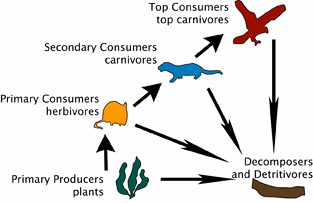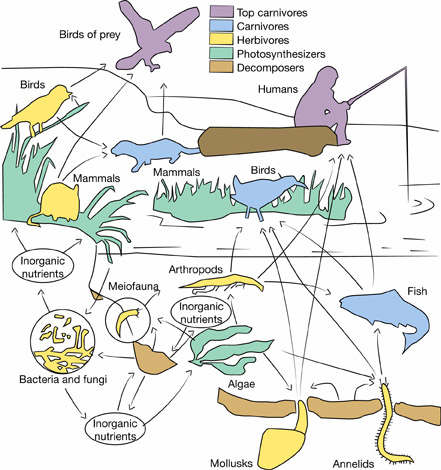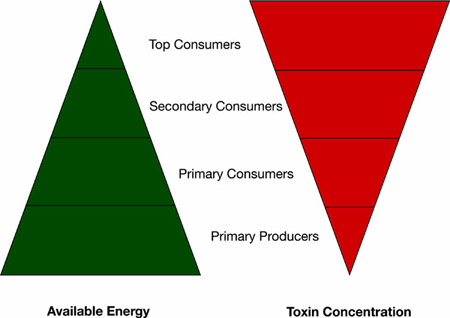 username@email.com
username@email.com
In this lesson, you will review the components of ecosystems. Scientists, regardless of their specialization, need to possess a basic level of science literacy across all disciplines. This lesson provides an overview of the major concepts pertaining to ecosystems that all students of the sciences should know. The chapters that follow will focus in greater detail on these ideas.
Ecosystems are organized, just as cells and organisms are organized. Individual organisms are members of populations. A population is a group of organisms of the same species living in the same area. Multiple populations of different species make up a community within that area. A community of living things and the abiotic environment of those organisms constitutes an ecosystem. All of the living systems of the earth constitute the biosphere.
organism → population → community → ecosystem → biosphere
Just as in a cell or an organism, an ecosystem has constant flows of energy and cycling of materials. Those flows are generated by the metabolism of the organisms within the ecosystem. Almost all of the energy in living things on earth ultimately comes from the sun.

Heterotrophic organisms cannot produce their own food and so must consume other organisms. Primary consumers are the herbivores that eat the producers. They occupy the second trophic level in the food chain. Secondary consumers feed on other consumers; they are carnivores. Top consumers, such as humans, are often omnivores meaning they have diverse diets of both plant and animal foods. They are characterized by being at the top of the food chain.
Detritivores, such as worms, and decomposers, such as bacteria and fungi, are important in recycling nutrients. They get their energy by feeding on dead organisms, either by actively ingesting them or by breaking them down and absorbing nutrients. When they do so, complex organic macromolecules are broken down into simpler forms and are returned to the environment. In nature, simple food chains are more likely to be complex food webs that continue the processes of energy transfer and cycling of nutrients.
A housecat eats a bird, which has eaten a caterpillar that feeds on leaves. Which trophic level describes the house cat?
D is the correct answer. The housecat is the top consumer in our food chain example. The leaf is the primary producer and the caterpillar the primary consumer. The bird is the secondary consumer.
A simple food web might look like this: In a meadow, grass, wildflowers, and a few small shrubs are the primary producers. Insects, mice, and rabbits all feed on the plants and seeds. Some insects feed on decomposing organic matter or parasitize animals. Some bird species also feed on seeds, while others eat insects and earthworms. Snakes feed on mice, rabbits, and birds. Falcons eat mice, rabbits, and snakes. Bacteria and fungi decompose dead plants and animals, and earthworms break down other dead organic material.

Most of the energy in any ecosystem is at the lowest trophic level, the primary producers. At each trophic level, about 90% of the available energy is used by an organism to grow and reproduce or is lost as heat; only 10% is transferred to the next level. Because of this, it takes many primary producers to support a few top consumers. For every 1,000 calories of energy present in the primary producers of an ecosystem, only 1 calorie is available for a top consumer. At the same time, environmental pollutants become more concentrated at each trophic level. That is why top consumers like birds of prey and humans are particularly susceptible to pollutants such as DDT.
